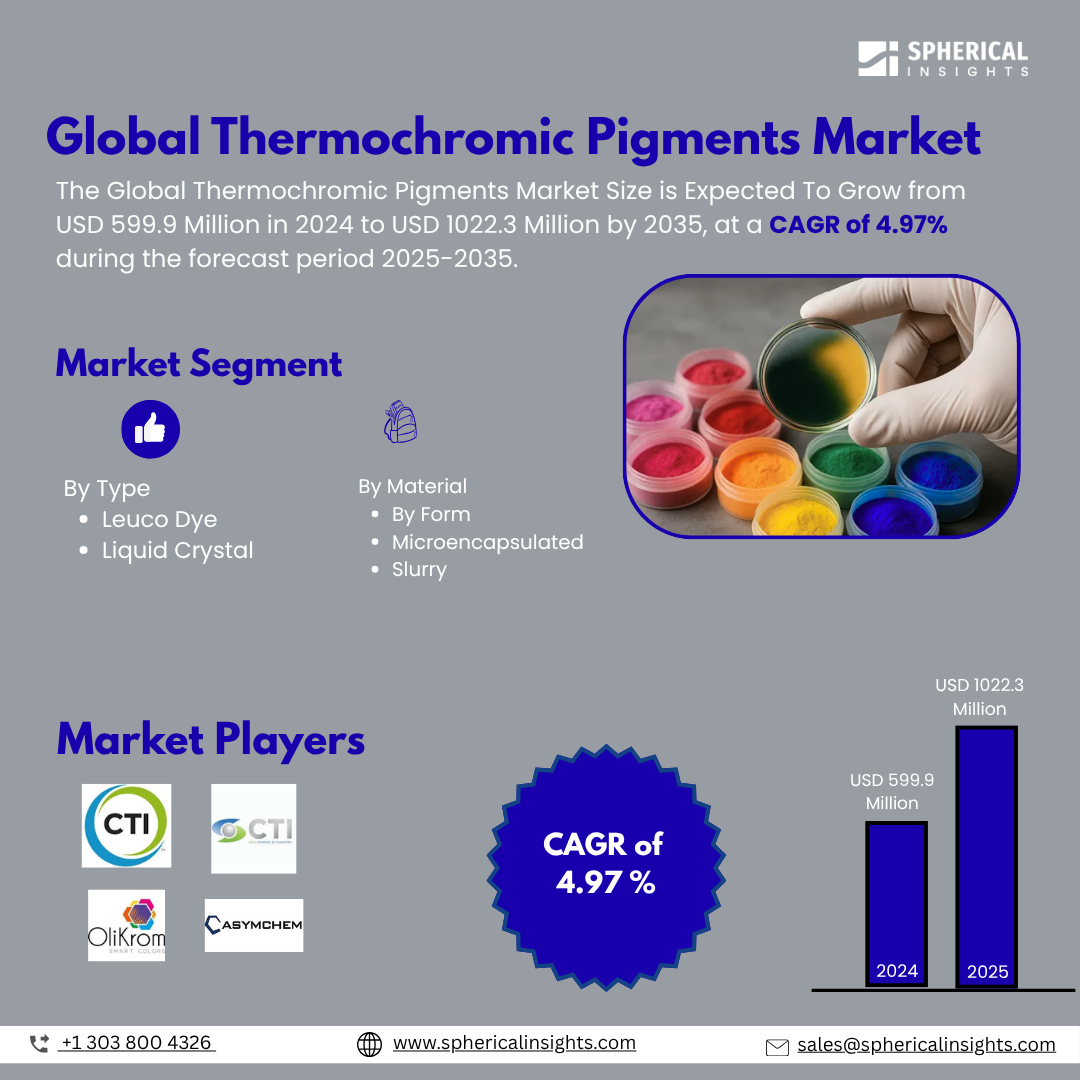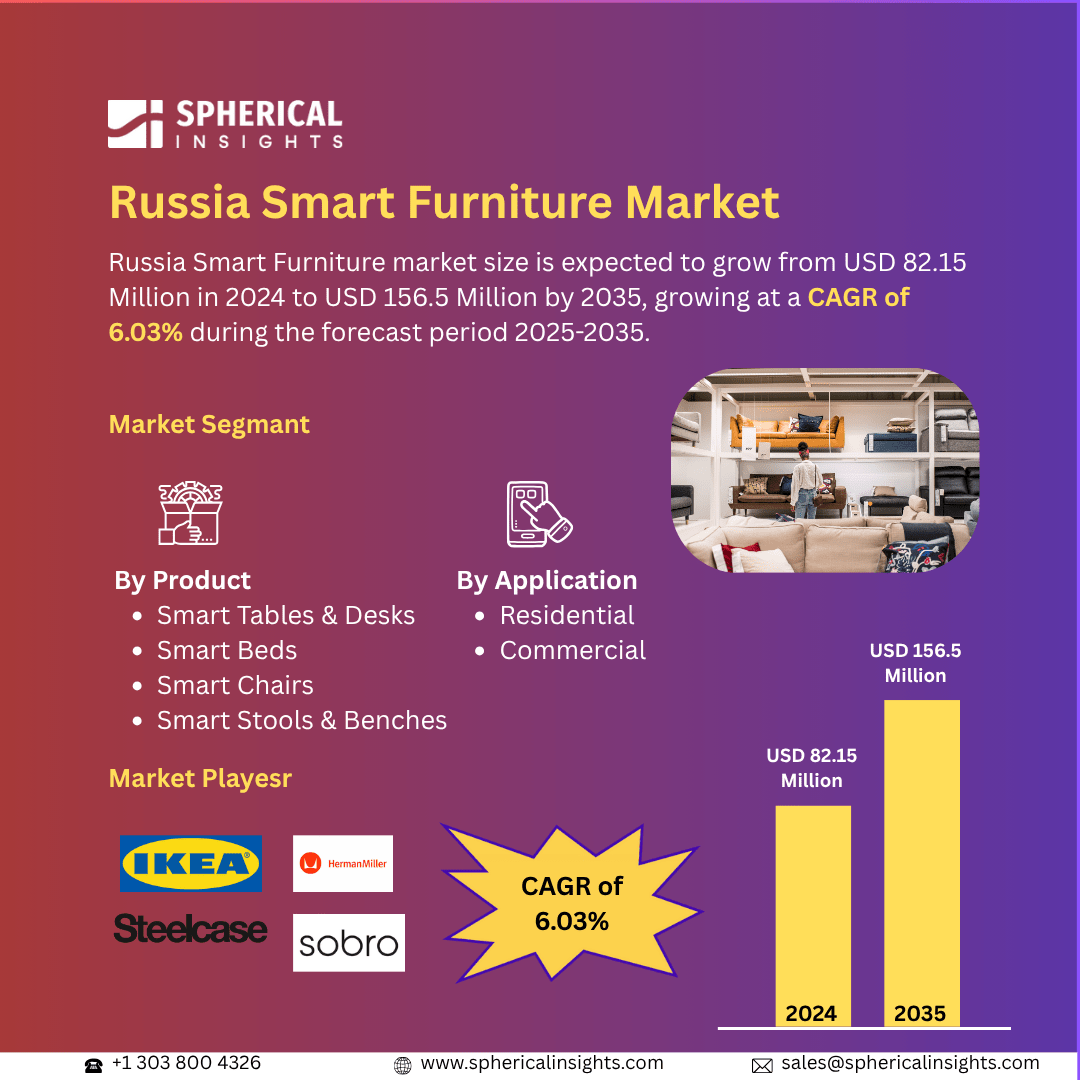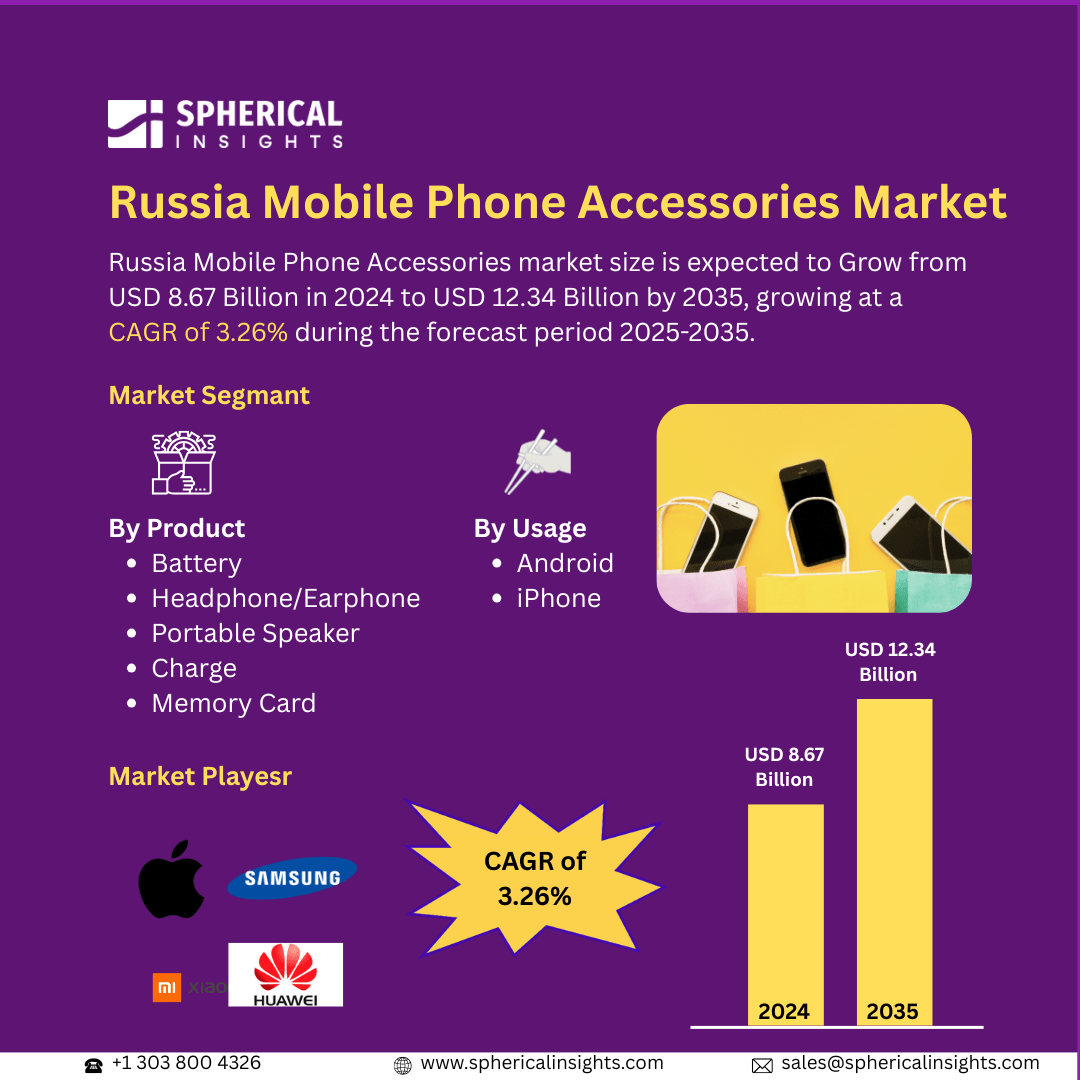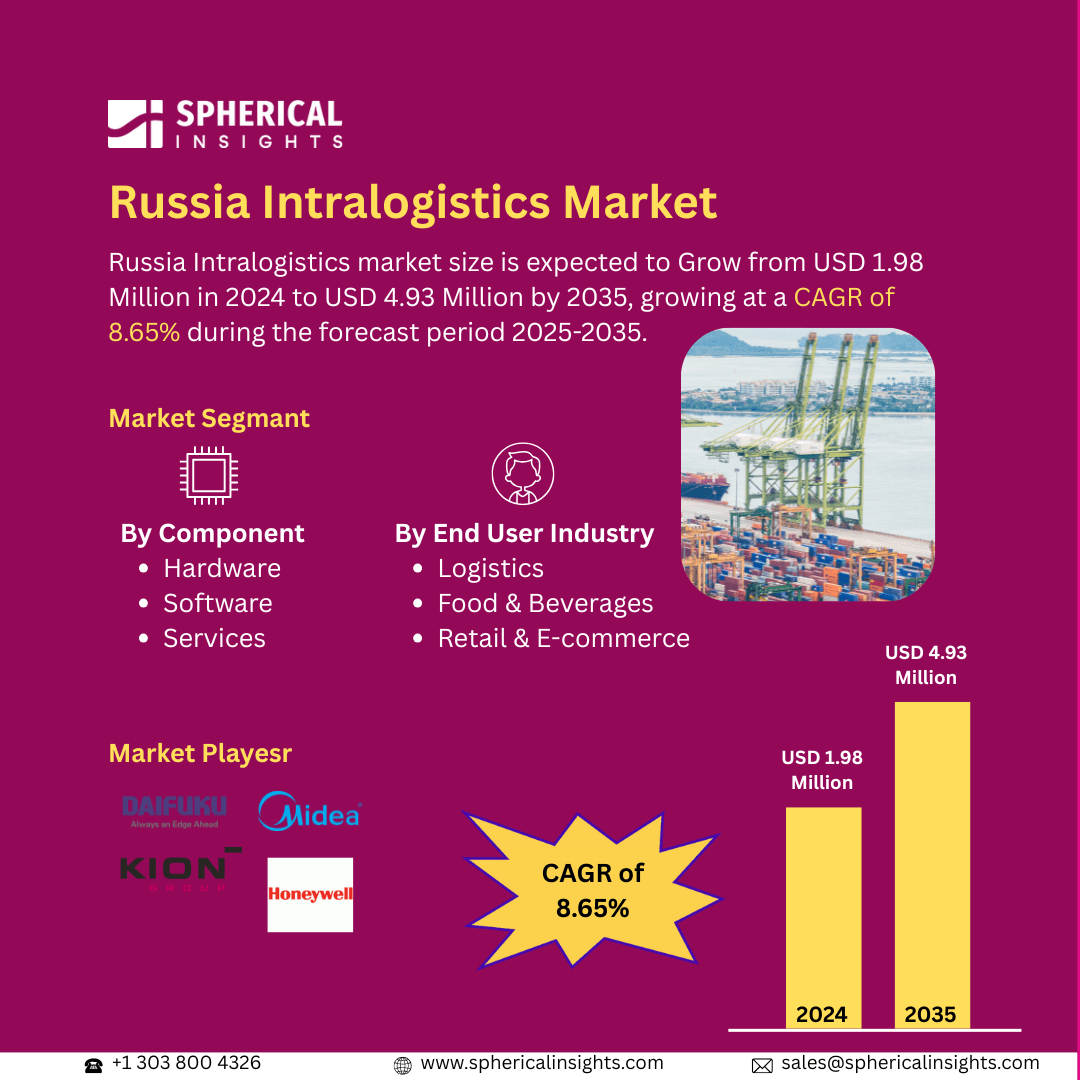Thermochromic Pigments Market Summary, Size & Emerging Trends
According to Decision Advisor, The Global Thermochromic Pigments Market Size is Expected To Grow from USD 599.9 Million in 2024 to USD 1022.3 Million by 2035, at a CAGR of 4.97% during the forecast period 2025-2035. Rising demand for smart coatings, temperature-sensitive inks, and color-changing applications in packaging, automotive, and textiles is a key factor driving market growth.
Key Market Insights
- Asia Pacific is expected to account for the largest share in the thermochromic pigments market size during the forecast period.
- In terms of type, the leuco dye segment dominated in terms of revenue during the forecast period.
- In terms of form, the microencapsulated segment accounted for the largest revenue share in the global thermochromic pigments market size during the forecast period.
Global Market Forecast and Revenue Outlook
- 2024 Market Size: USD 599.9 Million
- 2035 Projected Market Size: USD 1022.3 Million
- CAGR (2025-2035): 4.97%
- Asia Pacific: Largest market in 2024
- North America: Fastest growing market
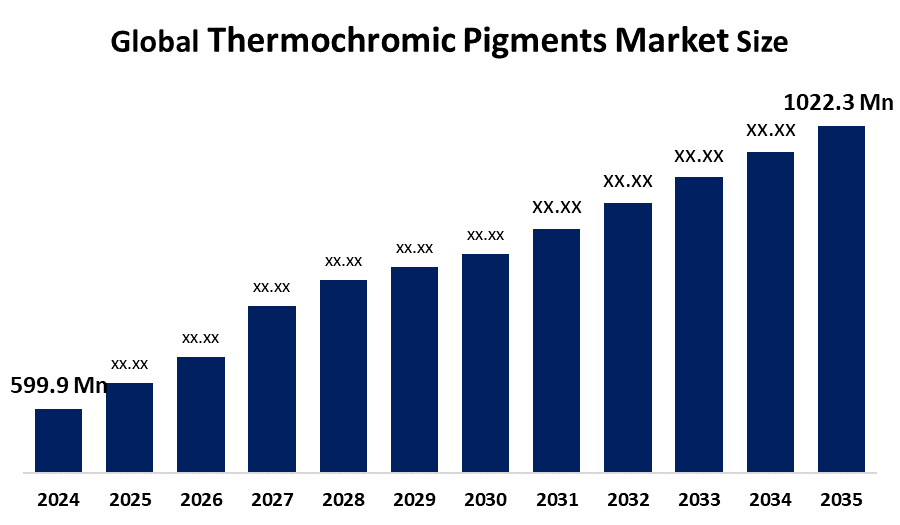
Thermochromic Pigments Market
The Thermochromic Pigments Market Size revolves around materials that change color in response to temperature variations. These pigments are widely used in smart coatings, temperature-indicating labels, textiles, plastics, and inks. The market is driven by innovations in microencapsulation technology, enabling better durability and stability of color-changing effects. Governments and industry organizations are increasingly supporting sustainable and safe chemical formulations, boosting adoption in consumer goods and industrial applications. With increasing demand for smart packaging, safety indicators, and interactive consumer products, the thermochromic pigments market is poised for steady growth.
Thermochromic Pigments Market Trends
- Development of eco-friendly and non-toxic thermochromic pigments for consumer and food packaging.
- Integration with smart packaging and wearable technology to enhance user interactivity.
- Strategic mergers and partnerships to expand product portfolios and global reach.
Thermochromic Pigments Market Dynamics
Driving Factors: Growing demand in smart packaging, automotive, and textile sectors
The Thermochromic Pigments Market Size is witnessing significant growth due to rising consumer interest in interactive and safety-sensitive products. Industries such as smart packaging, automotive, and textiles are increasingly adopting temperature-sensitive inks, coatings, and fabrics that offer both functional and aesthetic benefits. Technological advancements, particularly in microencapsulation and liquid crystal pigments, have improved the stability, durability, and performance of these materials, making them more attractive for industrial applications. These innovations allow manufacturers to deliver high-quality, reliable products that respond to temperature changes, boosting overall adoption and driving market expansion globally.
Restrain Factors: High production costs and limited technical awareness
Despite the growing demand, the market faces challenges related to high manufacturing costs and complex production processes. Producing thermochromic pigments requires specialized equipment and expertise, which limits adoption in emerging regions where technical know-how may be scarce. Additionally, substitutes such as photochromic or photo-thermochromic pigments pose a competitive threat, potentially restricting market growth. Stringent environmental and regulatory standards further complicate production, requiring compliance measures that can increase costs and slow adoption rates.
Opportunity: Expansion in emerging economies and innovative applications
Emerging economies present significant growth opportunities due to increasing industrialization, disposable income, and adoption of high-end consumer products. Thermochromic pigments are finding new applications in smart packaging, food safety indicators, wearable devices, and building materials. The surge of e-commerce and demand for premium, interactive products opens avenues for innovative solutions. Moreover, ongoing technological advancements in producing stable, long-lasting thermochromic pigments enable their integration into automotive coatings, textiles, and interactive consumer goods, supporting market diversification and premium product development.
Challenges: Supply chain volatility and regulatory compliance
Market players must navigate challenges such as raw material price fluctuations, supply chain disruptions, and strict adherence to environmental regulations. Maintaining consistent quality while complying with international safety standards is crucial to sustain competitiveness. Any disruption in the availability of key raw materials or delays in regulatory approvals can impact production timelines and profitability. Companies must adopt efficient supply chain strategies and sustainable practices to ensure reliable production, mitigate risks, and maintain their market position.
Global Thermochromic Pigments Market Ecosystem Analysis
The Global Thermochromic Pigments Market Size ecosystem comprises raw material suppliers, pigment manufacturers, and end-users across textiles, coatings, plastics, and packaging industries. Suppliers, especially in China and India, play a key role in determining availability and pricing. Manufacturers focus on innovation, ensuring product safety, and adopting sustainable production methods. End-users drive demand for thermochromic pigments by integrating color-changing materials into functional and aesthetic applications, including smart packaging, interactive textiles, and temperature-sensitive coatings, supporting overall market growth and technological advancement.
Global Thermochromic Pigments Market, By Type
The leuco dye segment dominates the global thermochromic pigments market, accounting for approximately 65% of the total market share. Its popularity stems from high color-change efficiency, cost-effectiveness, and versatility across multiple industries. Leuco dyes are widely used in inks, coatings, and textiles, offering reliable and visually appealing temperature-responsive effects. Their ease of formulation and integration into consumer and industrial products reinforces their leading position in the market.
The liquid crystal segment holds around 35% of the market share and is experiencing steady growth. These pigments are favored in high-end applications such as automotive coatings, temperature sensors, and smart displays due to their precise, reversible, and easily tunable color-changing properties. Although more expensive than leuco dyes, their advanced functionality makes them essential for premium products and specialized industrial applications.
Global Thermochromic Pigments Market, By Form
The microencapsulated form dominates the global thermochromic pigments market, size capturing approximately 70% of the market share. Encapsulation technology encloses the pigment within a protective shell, enhancing stability, preventing premature color change, and improving shelf life. This makes microencapsulated pigments highly suitable for diverse applications such as coatings, inks, textiles, and packaging materials. Their durability and consistent performance under varying temperature conditions make them the preferred choice for both industrial and consumer applications. Additionally, microencapsulation allows precise control over color-change thresholds, enabling high-performance formulations for smart packaging, safety indicators, and interactive consumer products, driving strong adoption globally.
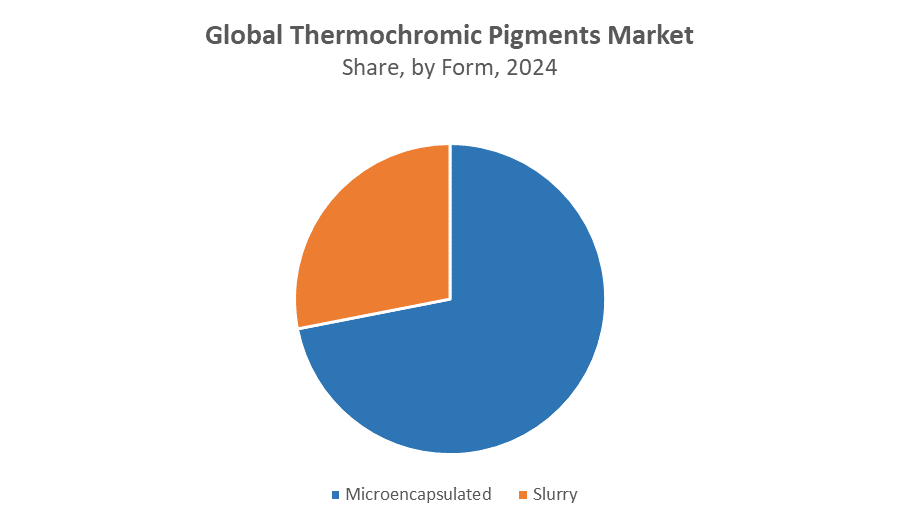
The slurry form holds roughly 30% of the market share and is gaining traction in applications that demand ease of mixing and direct application. It is commonly used in industrial paints, specialty coatings, and plastics, where seamless integration into existing manufacturing processes is critical. While slurry pigments are less stable than microencapsulated forms, they provide flexibility for large-scale or continuous production processes. Their ability to deliver functional color-changing effects without complex processing makes them valuable in niche applications, including decorative coatings, thermosensitive industrial products, and experimental smart materials. As industries explore innovative applications, the demand for slurry thermochromic pigments is gradually increasing.
Asia Pacific is poised to account for the largest share of the global thermochromic pigments market, driven by rapid industrialization, robust textile manufacturing, and continuous innovations in packaging across countries like China, India, and Japan. China dominates due to its extensive production of smart textiles, temperature-sensitive inks, and coatings for packaging applications. Japan leads in high-tech applications such as liquid crystal pigments for automotive coatings, electronic displays, and industrial sensors. India’s expanding consumer goods sector and growing adoption of interactive packaging contribute significantly to regional demand. Additionally, government initiatives promoting industrial modernization and sustainable manufacturing practices support the region’s market growth.
India is expected to grow at a strong CAGR of approximately 10% over the forecast period. Key growth drivers include the rising adoption of smart packaging, thermosensitive textiles, and temperature-indicating consumer products. Investments in modern manufacturing facilities, increasing export opportunities, and government support for chemical and textile innovation further boost the market. Regional hubs like Maharashtra, Tamil Nadu, and Gujarat are witnessing heightened activity in pigment production and application development.
North America is projected to experience significant growth due to increasing use of thermochromic pigments in automotive coatings, high-end consumer products, smart packaging, and temperature-sensitive labels. The United States, home to leading pigment manufacturers and smart packaging innovators, drives regional demand. Growing consumer awareness of safety indicators, interactive packaging, and temperature-monitoring products further stimulates adoption. Additionally, advancements in microencapsulation and liquid crystal pigment technologies allow manufacturers to meet strict quality and environmental standards, positioning North America as a key growth region.
WORLDWIDE TOP KEY PLAYERS IN THE THERMOCHROMIC PIGMENTS MARKET INCLUDE
- Chromatic Technologies Inc. (CTI)
- LCR Hallcrest LLC
- Matsui Shikiso Chemical Co., Ltd.
- OliKrom SA
- QCR Solutions Corp.
- SFXC
- Smarol Industries Co., Ltd.
- Kolortek Co., Ltd.
- Hali Pigment Co., Ltd.
- New Color Chemical Co., Ltd.
- Others
-
Market Segment
This study forecasts revenue at global, regional, and country levels from 2020 to 2035. Decision Advisor has segmented the Thermochromic Pigments market based on the below-mentioned segments:
Global Thermochromic Pigments Market, By Type
Global Thermochromic Pigments Market, By Form
Global Thermochromic Pigments Market, By Regional Analysis
- North America
- Europe
- Germany
- UK
- France
- Italy
- Spain
- Russia
- Rest of Europe
- Asia Pacific
- China
- Japan
- India
- South Korea
- Australia
- Rest of Asia Pacific
- South America
- Brazil
- Argentina
- Rest of South America
- Middle East & Africa
- UAE
- Saudi Arabia
- Qatar
- South Africa
- Rest of the Middle East & Africa
FAQs
Q: Which form of thermochromic pigment is most widely used?
A: Microencapsulated pigments dominate the market with roughly 70% share, valued for their stability, durability, and controlled color-change properties.
Q: What is the market share of slurry thermochromic pigments?
A: Slurry pigments account for about 30% of the market, used in industrial paints, plastics, and specialty coatings due to ease of mixing and direct application.
Q: Which countries are leading in the Asia Pacific thermochromic pigments market?
A: China, Japan, and India lead the market. China dominates production, Japan leads in high-tech applications, and India shows strong growth due to adoption of smart packaging and thermosensitive textiles.
Q: What are the latest trends in the thermochromic pigments market?
A: Emerging trends include eco-friendly and non-toxic pigments, integration with smart packaging and wearable technology, and strategic mergers and partnerships to expand global reach.
Q: Who are the top companies operating in the Global Thermochromic Pigments Market?
A: Leading players include Chromatic Technologies Inc. (CTI), LCR Hallcrest LLC, Matsui Shikiso Chemical Co., OliKrom SA, QCR Solutions Corp., SFXC, Smarol Industries Co., Kolortek Co., Hali Pigment Co., and New Color Chemical Co., Ltd.
Q: What are the key opportunities in the thermochromic pigments market?
A: Opportunities include expansion in emerging economies, integration into smart packaging, wearable devices, building materials, and high-end interactive consumer products.
Q: What is the long-term outlook (2025–2035) for the thermochromic pigments market?
A: The market is expected to witness steady growth, driven by rising demand for smart coatings, interactive textiles, temperature-indicating labels, and sustainable chemical innovations.
